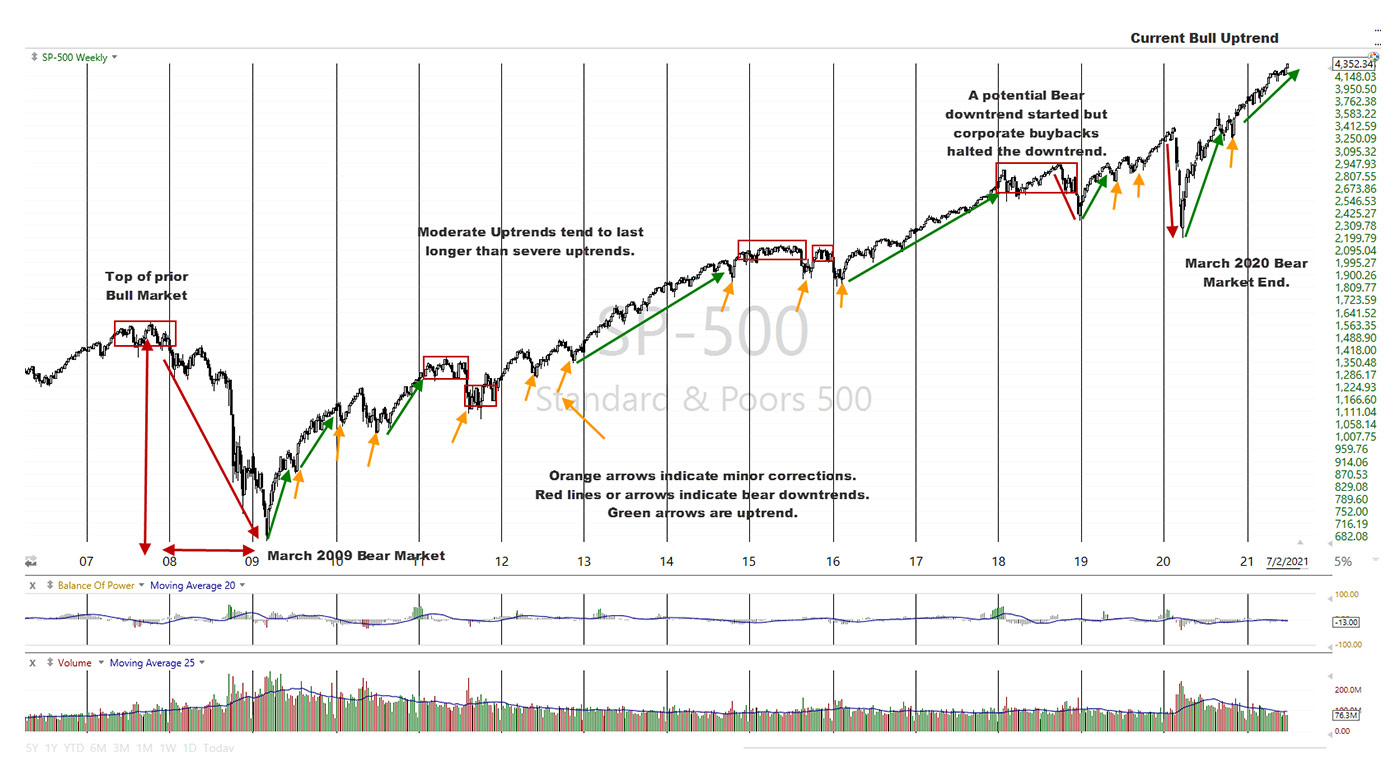

Relational Technical Analysis, which combines both technical and fundamental analysis of the modern market structure, is not a predictive tool. No analytical system can accurately predict the future. That said, history does repeat, and repetitive patterns are called cycles. These cycles can be used in analyzing stock market indexes. However, cycles are rarely identical in duration or in the depth or magnitude of the cycle pattern.
It is not the intent of Relational Technical Analysis to try to perfectly time the market. All technical analysis should be used strictly as a guideline as to what may happen in the future. It is not a mathematical equation to determine a precise measure of future index value.
The S&P 500 offers the most representative index for understanding the current and near-term market conditions. It is studied due to the broad number of components and the interpretive values it provides. The S&P 500 is also the most popular basis for index funds, and SPY—the primary ETF of the S&P 500—is the most popular ETF worldwide.
This analysis is a simple one that aids in envisioning the possible duration of the bull market trend for the S&P 500 after the briefest bear market ever documented. Many factors contributed to why the market corrected and recovered faster than any other recorded market crash:
- The speed at which the Federal Reserve reacted to the imminent lockdown of the U.S. and global economies, providing trillions in lending, credit lines, and bond funding (in addition to cutting the fed funds rate). This helped enormously in propping up the economy and stocks that were in a free fall due to the investor reaction to the lockdown.
- The sudden and unexpected surge of 10 million new investors, with a larger percentage falling in younger age groups than typically seen. The Robinhood brokerage, with its “free trades” marketing strategy, has become the most publicized (and criticized) symbol of the growing prominence of self-directed retail investors.
- The surprising resiliency and rapid response of the majority of Fortune 500 companies to the crisis and their business structure reorganization. While many corporations and industries freely admitted to being unprepared for the crisis, the response was nonetheless impressive.
- The fact that, despite the lockdown, over 80% of the U.S. workforce continued working at its worst point and earning income. The unemployment rate moved steadily lower over the ensuing months from March 2020.
- The government’s strategy for economic stimulus checks, distributed at a record pace to the bank accounts of most lower- and middle-class Americans, increasing disposable income for millions of families.
As the indexes rebounded quickly off their value lows, millions of 401(k) and IRA accounts were “saved” before most people could even contemplate making emotionally driven decisions about their investments. The vast majority of pension funds offer S&P 500 index funds in one form or another.
Sources: Market data, technitrader.com
There are three basic, but important, trends to recognize in the modern automated stock market:
- The uptrend.
- The downtrend.
- The sideways trend.
When the index uptrend starts to trend sideways, this is a form of a correction and frequently results in a minor correction. The red rectangles on the chart show the sideways trends, which mostly ended with a minor decline in index value or, in some cases, a bear downtrend. The minor corrections are a natural and necessary value action to help sustain the long-term bull uptrend.
The more severe bear downtrends tend to rebound with an accelerated uptrend that is often too steep to sustain and is followed by another minor correction.
Starting in 2018, the majority of industries in the S&P 500 entered a bearish industry cycle. However, the impact on the Index was minimal at that time due to over $1 trillion that major corporations spent in 2018 to buy back outstanding shares of their company’s stock. (This was part of a five-year period of buybacks that exceeded $3 trillion.) This disrupted the bear downtrend, ending it quickly. The uptrend resumed for the indexes but not necessarily for the many S&P 500 component stocks.
When the uptrend or downtrend goes nearly vertical, a sudden and possibly short-term turn in the opposite direction often occurs. This pattern is visible in 2009, 2018, and 2020.
At the time of the writing of this article (July 7, 2021), some important fundamental indicators are beginning to trail behind the broad market’s index value. A short-term correction would help maintain the uptrend.
The long-term trend of the chart shows that when the bear downtrend ended in March 2009, a long-term bull market continued until February 2020—almost exactly 11 years. This provides an interesting perspective on what may be possible for the duration of the young bull market currently underway since March 2020.
 Martha Stokes, CMT, is the co-founder and CEO of TechniTrader and a former buy-side technical analyst. Since 1998, she has developed over 40 TechniTrader stock and option courses. She specializes in relational analysis for stocks and options, as well as market condition analysis. An industry speaker and writer, Ms. Stokes is a member of the CMT Association and earned the Chartered Market Technician designation with her thesis, "Cycle Evolution Theory." technitrader.com
Martha Stokes, CMT, is the co-founder and CEO of TechniTrader and a former buy-side technical analyst. Since 1998, she has developed over 40 TechniTrader stock and option courses. She specializes in relational analysis for stocks and options, as well as market condition analysis. An industry speaker and writer, Ms. Stokes is a member of the CMT Association and earned the Chartered Market Technician designation with her thesis, "Cycle Evolution Theory." technitrader.com

